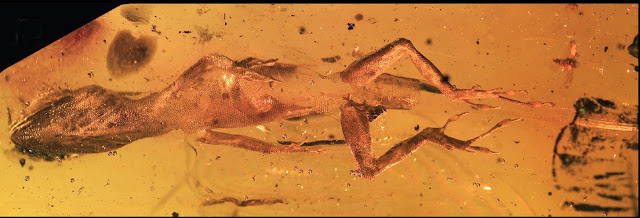
Tiny Anolis lizards preserved since the Miocene in amber are giving scientists a true appreciation of the meaning of community stability. Dating back some 15 to 20 million years, close comparison of these exquisitely preserved lizard fossils with their descendants alive today in the Caribbean has revealed, remarkably, little about them has changed.
“Not only do we see the community structure of these lizards has remained stable for 20 million years, it’s also difficult to tell some of these fossil lizards apart from those alive today,” says Kevin de Queiroz, a herpetologist at the Smithsonian’s National Museum of Natural History and co-author of a study which appeared today in the Proceedings of the National Academy of Sciences.
After first appearing on each of the four Greater Antillean Islands some 50 million years ago, Anolis lizards spread out on each island to occupy various niches in island trees. Some ended up living high-up in the canopy area, others low down on the trunk near the ground; others established themselves in the mid-trunk area while others adapted and thrived on the twigs. Each new species developed its own distinct body type, called an ecomorph, shaped by the specific tree niche where it lived.
Until recently, scientists had only indirect estimates based on amounts and patterns of molecular (DNA sequence) divergence as to just how long this community structure of tree-living lizards, each specialized to a different niche and living together, had existed in the Antilles. Now, amber fossils reveal it has been an incredibly long time: some 20 million years or greater. Four modern ecomorph body types (trunk-crown, trunk-ground, trunk and twig) are represented in the amber fossils.
“For other types of organisms, like mammals, 20 million years would be quite an extraordinary period for a species to last,” de Queiroz points out. “The community could persist longer than the species, with different species filling the various roles in the same ecological community over time.”
Niche shifts or changes of Anolis lizards occurred independently from island to island, producing ecomorphs on different islands that closely resemble one another. For example, lizards from the trunk-crown area of the tree are normally large- or medium-sized and green, and they resemble one another from island to island. Looks can be misleading, however. Although lizards of the same ecomorph from different islands may look alike, they are more closely related to lizards from their home islands, which may look much more different.
The long-term stability of these lizard communities doesn’t mean their environment has also been stable, de Queiroz adds. “What makes this discovery more remarkable is that these lizard communities have remained stable despite substantial environmental change that has occurred in the Antilles since the Miocene.”
Reference:
“Amber fossils demonstrate deep-time stability of Caribbean lizard communities.” PNAS 2015 ; published ahead of print July 27, 2015, DOI: 10.1073/pnas.1506516112
Note: The above post is reprinted from materials provided by Smithsonian.










